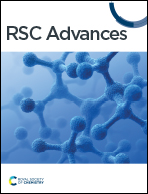Surface-enhanced Raman spectroscopy for the characterization of bacterial pellets of Staphylococcus aureus infected by bacteriophage†
Abstract
Drug-resistant pathogenic bacteria are a major cause of infectious diseases in the world and they have become a major threat through the reduced efficacy of developed antibiotics. This issue can be addressed by using bacteriophages, which can kill lethal bacteria and prevent them from causing infections. Surface-enhanced Raman spectroscopy (SERS) is a promising technique for studying the degradation of infectious bacteria by the interaction of bacteriophages to break the vicious cycle of drug-resistant bacteria and help to develop chemotherapy-independent remedial strategies. The phage (viruses)-sensitive Staphylococcus aureus (S. aureus) bacteria are exposed to bacteriophages (Siphoviridae family) in the time frame from 0 min (control) to 50 minutes with intervals of 5 minutes and characterized by SERS using silver nanoparticles as SERS substrate. This allows us to explore the effects of the bacteriophages against lethal bacteria (S. aureus) at different time intervals. The differentiating SERS bands are observed at 575 (C–C skeletal mode), 620 (phenylalanine), 649 (tyrosine, guanine (ring breathing)), 657 (guanine (COO deformation)), 728–735 (adenine, glycosidic ring mode), 796 (tyrosine (C–N stretching)), 957 (C–N stretching (amide lipopolysaccharides)), 1096 (PO2 (nucleic acid)), 1113 (phenylalanine), 1249 (CH2 of amide III, N–H bending and C–O stretching (amide III)), 1273 (CH2, N–H, C–N, amide III), 1331 (C–N stretching mode of adenine), 1373 (in nucleic acids (ring breathing modes of the DNA/RNA bases)) and 1454 cm−1 (CH2 deformation of saturated lipids), indicating the degradation of bacteria and replication of bacteriophages. Multivariate data analysis was performed by employing principal component analysis (PCA) and partial least squares-discriminant analysis (PLS-DA) to study the biochemical differences in the S. aureus bacteria infected by the bacteriophage. The SERS spectral data sets were successfully differentiated by PLS-DA with 94.47% sensitivity, 98.61% specificity, 94.44% precision, 98.88% accuracy and 81.06% area under the curve (AUC), which shows that at 50 min interval S. aureus bacteria is degraded by the replicating bacteriophages.



 Please wait while we load your content...
Please wait while we load your content...